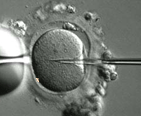Many people, who are not able to have children naturally, choose alternative methods of conception , and in vitro fertilization is one of them.
What is it?
In vitro fertilization (IVF) is a certain technique during which a human egg is fertilized outside the body under laboratory conditions. This method is a worldwide spread technique to help infertile couples conceive a baby when other means of conception have failed.
History of IVF
In vitro fertilization procedure was first created by British scientists, an embryologist Dr. Edwards and a gynecologist Dr. Steptoe. It was performed successfully for the firs time in 1978.
About 1% of all babies are born through IVF procedure. Nearly 120,000 babies are born after IVF in the United States alone. The possibility to have a continuous pregnancy after IVF procedure has improved; it ranges from 17% to 25%, although earlier it was practically zero.
Process of IVF
 In vitro fertilization procedure has several stages. A woman has to undergo two week long intensive preparation in order to receive several healthy eggs for the procedure. A woman will have to take hormonal preparations during this period. The doctor will know the exact time for taking the eggs from the ovaries by performing blood tests and ultrasound scan of the ovaries. The proper time to take the eggs is just before the ovulation, when the eggs are nearly ready to be fertilized.
In vitro fertilization procedure has several stages. A woman has to undergo two week long intensive preparation in order to receive several healthy eggs for the procedure. A woman will have to take hormonal preparations during this period. The doctor will know the exact time for taking the eggs from the ovaries by performing blood tests and ultrasound scan of the ovaries. The proper time to take the eggs is just before the ovulation, when the eggs are nearly ready to be fertilized.
Another step is to take the eggs for in vitro fertilization. This is a simple procedure, during which a needle through a vaginal wall is injected under local anesthesia and oocites (eggs) are gathered. Some women may experience discomfort during the procedure. This feeling is usually described as a minor discomfort similar to that of a Pap smear. A woman is able to go back to her normal routine straight after the procedure.
The fluid from the ovaries is kept under physiological conditions in the lab until the eggs are ready to be fertilized. Then the oocites are placed together with the sperm and hence fertilized. Normally, the eggs develop into pre-embryos that are ready to be implanted into the uterus for further development.
These pre-embryos are placed through the vagina into the uterus about two days after their retrieval by a special catheter. A woman should stay quietly in bed for about an hour. She is then able to go back home and return to her normal daily routine.
The patient will have to come back to the clinic in two weeks after the pre-embryo transfer for the pregnancy test. Usually the doctor prescribes progesterone for this period, since this hormone helps the uterine lining to be thick and suitable for implantation.
Indications
A healthy egg, sperm able to fertilize an egg and the uterus that is healthy to manage a pregnancy is needed for in vitro fertilization. Usually, IVF is chosen when all other options of fertilization have failed.
In vitro fertilization complications
In vitro fertilization has certain risks and complications, one of the most frequent being multiple births. This results from the routine to place more than one pre-embryo during the transfer period. Although strict regulations have been made in order to minimize the number of pre-embryos transferred, these restrictions are not being followed everywhere. Multiple births cause a greater risk for pregnancy loss, obstetrical complications, prematurity and neonatal morbidity, as well as premature labor.
Another complication is a so called ovarian hyperstimulation syndrome, occurring due to hormonal therapy prior to retrieval of the eggs.
An increased risk of births defects after IVF have not been proved by significant study data.
In vitro fertilizatin cost
One cycle of IVF procedure usually costs from $10,000 to $15,000. Usually, a couple needs more than one cycle of in vitro fertilization procedure until continuous and successful pregnancy is achieved.